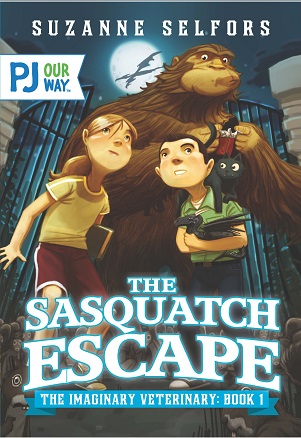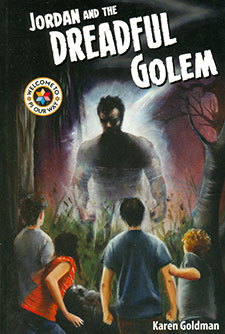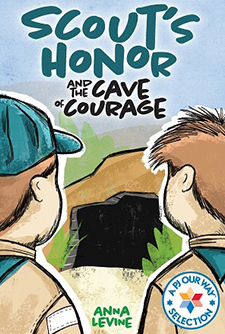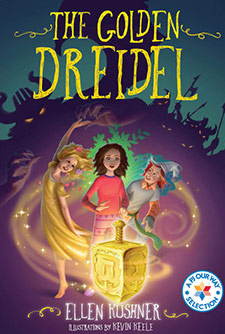The Sasquatch Escape
Look what the cat dragged in…a baby dragon?
What’s really going on at the old button factory?
Ben and Pearl are determined to find out.
Average Rating
( hint: Login to leave a review! )
222 Reviews
Leave Review
What the Book is About
Jewish Content & Values
Positive Role Models
Content Advisory
Talk It Over
More for You
What the Book is About
When 10-year-old Ben Silverstein is sent to spend the summer with his grandfather Abe in the tiny rundown town of Buttonville, he’s sure it’s going to be the most boring eight weeks of his life. Fortunately, things get a little more exciting when Ben’s grandfather’s cat brings home an injured baby dragon. Along with the help of Pearl Petal, the town troublemaker, Ben discovers that the old button factory on the edge of town is actually a secret hospital for imaginary creatures. When Ben and Pearl bring the baby dragon there for treatment, they accidentally set a sasquatch free on the town! Thankfully, the mysterious Dr. Woo has left a Sasquatch Catching Kit along with detailed instructions. Between the imaginary creatures, the ridiculous antics of the sasquatch, and the children’s bravery, there is plenty of humor and adventure that younger readers will love.
Jewish Content & Values
- Ben’s grandfather, Abe Silverstein, is Jewish. Abe has a mezuzah on his doorpost, and he uses a variety of Yiddish words and phrases. He also eats kosher food, including hot dogs, brisket, and knishes.
- There are several references to Shabbat, including Abe’s Shabbat candlesticks, eating challah, and counting the stars to determine when Shabbat is over.
- The children’s commitment to caring for the animals (both real and imaginary) in the story is an excellent example of tza’ar ba’alei chayim, the Jewish prohibition against causing unnecessary suffering to animals.
Positive Role Models
- Even though Ben isn’t excited about spending the summer with his grandfather, he quickly adapts to his new situation. He’s helpful to his grandfather and eager to make new friends. He cares deeply about animals and works hard to keep all the animals in his life safe.
- Ben’s grandfather, Abe, is a kind man who is welcoming to his grandson and committed to his community.
- Dr. Woo, a veterinarian who works with imaginary creatures, gives the children clear instructions explaining how to capture the Sasquatch without agitating or injuring it. At the end of the book, she offers them each a summer apprenticeship.
Content Advisory
None.
Talk It Over
If you could meet one mythical animal (dragon, unicorn, pegasus, phoenix, sasquatch, etc.), which one would you choose and why?
More for You
Jewish folklore includes a long history of mythological creatures. The behemoth is a large creature similar to an elephant or rhinoceros, and the leviathan is a sea monster; both are depicted in the Book of Job and other biblical stories. The re’em, which has been described as either a unicorn or oryx, appears nine times in the Tanakh, or Hebrew Bible. The ziz is a giant bird that has been compared to both the griffin and the phoenix. Finally, the shamir is a mystical worm capable of cutting through stone and diamond; according to Jewish legend, King Solomon used it to build the First Temple in Jerusalem, as iron tools that could be used for violence should not be used to build a temple to peace.
What the Book is About
What the Book is About
When 10-year-old Ben Silverstein is sent to spend the summer with his grandfather Abe in the tiny rundown town of Buttonville, he’s sure it’s going to be the most boring eight weeks of his life. Fortunately, things get a little more exciting when Ben’s grandfather’s cat brings home an injured baby dragon. Along with the help of Pearl Petal, the town troublemaker, Ben discovers that the old button factory on the edge of town is actually a secret hospital for imaginary creatures. When Ben and Pearl bring the baby dragon there for treatment, they accidentally set a sasquatch free on the town! Thankfully, the mysterious Dr. Woo has left a Sasquatch Catching Kit along with detailed instructions. Between the imaginary creatures, the ridiculous antics of the sasquatch, and the children’s bravery, there is plenty of humor and adventure that younger readers will love.
Jewish Content & Values
Jewish Content & Values
- Ben’s grandfather, Abe Silverstein, is Jewish. Abe has a mezuzah on his doorpost, and he uses a variety of Yiddish words and phrases. He also eats kosher food, including hot dogs, brisket, and knishes.
- There are several references to Shabbat, including Abe’s Shabbat candlesticks, eating challah, and counting the stars to determine when Shabbat is over.
- The children’s commitment to caring for the animals (both real and imaginary) in the story is an excellent example of tza’ar ba’alei chayim, the Jewish prohibition against causing unnecessary suffering to animals.
Positive Role Models
Positive Role Models
- Even though Ben isn’t excited about spending the summer with his grandfather, he quickly adapts to his new situation. He’s helpful to his grandfather and eager to make new friends. He cares deeply about animals and works hard to keep all the animals in his life safe.
- Ben’s grandfather, Abe, is a kind man who is welcoming to his grandson and committed to his community.
- Dr. Woo, a veterinarian who works with imaginary creatures, gives the children clear instructions explaining how to capture the Sasquatch without agitating or injuring it. At the end of the book, she offers them each a summer apprenticeship.
Content Advisory
Content Advisory
None.
Talk It Over
Talk It Over
If you could meet one mythical animal (dragon, unicorn, pegasus, phoenix, sasquatch, etc.), which one would you choose and why?
More for You
More for You
Jewish folklore includes a long history of mythological creatures. The behemoth is a large creature similar to an elephant or rhinoceros, and the leviathan is a sea monster; both are depicted in the Book of Job and other biblical stories. The re’em, which has been described as either a unicorn or oryx, appears nine times in the Tanakh, or Hebrew Bible. The ziz is a giant bird that has been compared to both the griffin and the phoenix. Finally, the shamir is a mystical worm capable of cutting through stone and diamond; according to Jewish legend, King Solomon used it to build the First Temple in Jerusalem, as iron tools that could be used for violence should not be used to build a temple to peace.




